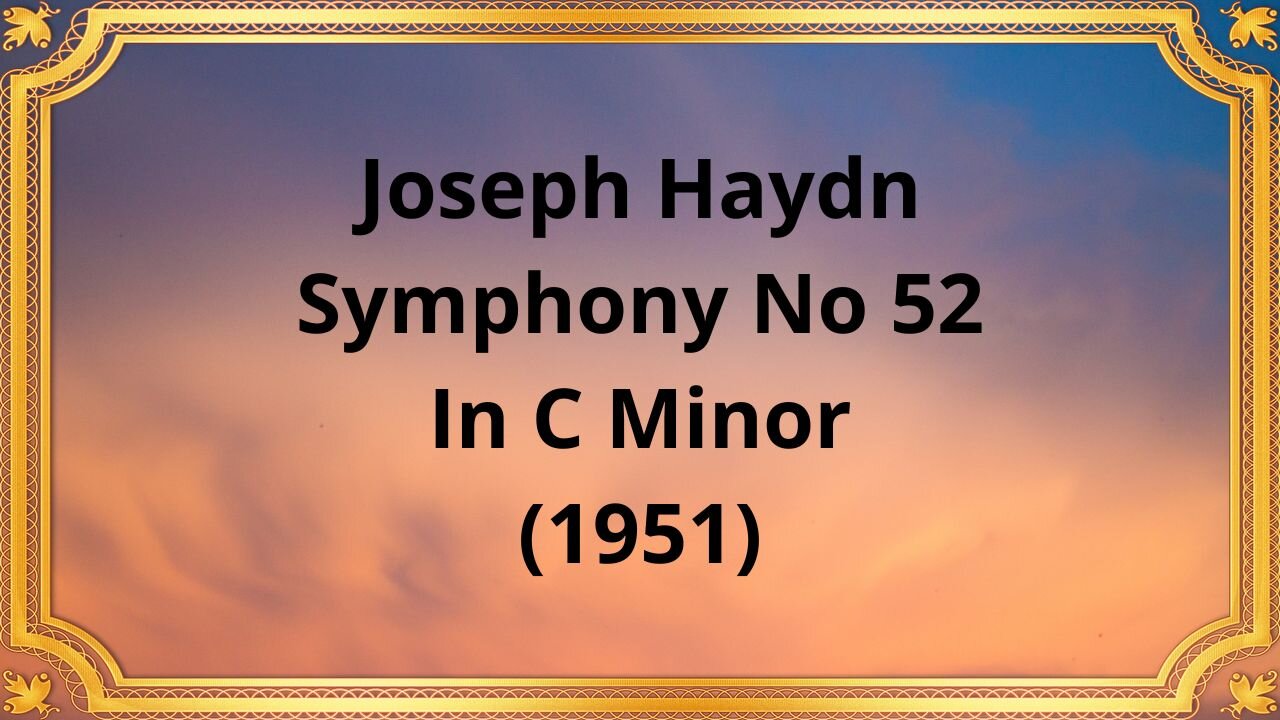Premium Only Content

Joseph Haydn Symphony No 52 In C Minor (1951)
#ClassicalMusic #JosephHaydn #SymphonyNo52 #CMajor #MusicalComposition #OrchestralMusic #ClassicalEra #HaydnSymphonies
#ClassicalComposers #MusicAppreciation
Publication date 1951
Orchester Der Wiener Staatsoper
Anton Heiller Conductor
Joseph Haydn's Symphony No. 52 in C Minor, also known as "The Grand Symphony," is a masterpiece of the classical era. Composed in 1771, it is one of Haydn's lesser-known symphonies but holds immense artistic significance.
Symphony No. 52 opens with a captivating and dramatic introduction in the minor key, setting the tone for the entire piece. As the music unfolds, Haydn skillfully alternates between moments of tension and resolution, creating a sense of musical narrative that keeps the listener engaged throughout.
The first movement, marked Allegro assai, showcases Haydn's mastery of orchestration and his ability to create dynamic contrasts. The symphony is predominantly characterized by its energetic and lively themes, with the orchestra engaging in a lively dialogue. The development section explores various thematic variations, showcasing Haydn's inventive compositional techniques.
The second movement, marked Andante, provides a stark contrast to the preceding movement. Here, Haydn demonstrates his unparalleled ability to evoke deep emotions through music. The slow tempo and lyrical melodies create a sense of introspection and introspection. The orchestration is delicate, with the strings taking center stage and weaving a melancholic tapestry of sound.
The third movement, marked Menuetto: Allegro, brings a sense of playfulness and charm to the symphony. Haydn's use of syncopation and rhythmic interplay adds a delightful touch to this movement, making it a joyful and spirited dance. The minuet is followed by a contrasting Trio section, which provides a moment of respite before returning to the lively minuet.
The finale, marked Presto, brings the symphony to a thrilling conclusion. Haydn's use of rapid-fire melodies, intricate counterpoint, and vibrant orchestration create a sense of exhilaration and intensity. The music builds up to a grand and triumphant finale, leaving the audience in awe of Haydn's compositional brilliance.
Haydn's Symphony No. 52 in C Minor is a testament to the composer's creativity and innovation. Through its dramatic intensity, emotional depth, and technical brilliance, this symphony showcases Haydn's mastery of the classical form. Despite being overshadowed by some of his more famous works, Symphony No. 52 stands as a testament to Haydn's genius and deserves recognition for its significant contributions to classical music.
In conclusion, Joseph Haydn's Symphony No. 52 in C Minor is a captivating musical composition that showcases the composer's mastery of orchestration, inventive compositional techniques, and ability to evoke a wide range of emotions. Its combination of dramatic intensity, lyrical beauty, and technical brilliance make it a true gem of the classical era.
You have the opportunity to support the channel:
https://destream.net/live/RadSiarAl/donate
-
 34:26
34:26
Classical music_Music Inspiration
1 month agoAram Khachaturian Concerto for Violin and Orchestra
802 -
 0:50
0:50
Sean Unpaved
13 hours ago $5.81 earnedWelcome “Unpaved w/ Sean Salisbury” to Rumble
33.4K4 -
 2:10:09
2:10:09
FreshandFit
6 hours agoKicking Out Old Annoying Hoes In Las Vegas!
56.4K78 -
 25:53
25:53
Stephen Gardner
9 hours ago🔥BREAKING: Trump HATING LAWYER busted in $17 million money laundering scheme!
35.2K104 -
 20:10
20:10
CartierFamily
15 hours agoAndrew Schulz DESTROYS Charlamagne’s WOKE Meltdown on DOGE & Elon Musk!
116K97 -
 33:56
33:56
The Why Files
9 days agoLegend of the 13 Crystal Skulls | From Mars to the Maya
71.2K39 -
 2:56:14
2:56:14
TimcastIRL
9 hours agoEPSTEIN Files DROP, FBI GOES ROGUE, AG Says They COVERED UP Epstein Case w/Amber Duke | Timcast IRL
190K105 -
 1:39:23
1:39:23
Kim Iversen
9 hours ago"Canada's Trump" Is Trudeau’s Worst Nightmare: Is Maxime Bernier the Future of Canada?
81.1K84 -
 DVR
DVR
Bannons War Room
10 days agoWarRoom Live
2.67M447 -
 16:06
16:06
The Rubin Report
16 hours agoProof the Islamist Threat in England Can No Longer Be Ignored | Winston Marshall
96.3K85